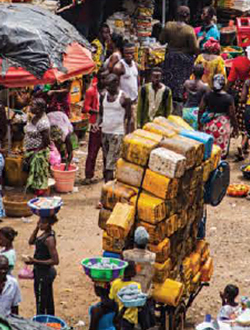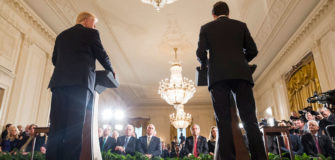Sierra Leone’s Prospects

 Reforms must reckon with a small market, high informality, and general policy incoherence
Reforms must reckon with a small market, high informality, and general policy incoherence
In the two-year period preceding the 2014 Ebola outbreak, Sierra Leone experienced the most dramatic spikes in its annual GDP growth rate since its civil war ended in 2002. This growth, reaching as high as 20.7 percent in 2013, was driven primarily by the extractive sector, led by iron ore and offshore oil prospects. However, when commodity prices fell sharply, and the devastating Ebola epidemic hit, the country suffered a devastating downturn, notwithstanding the increases in official aid transfers during the Ebola period. The value of the national currency, the Leone, dropped by almost 40 percent against major currencies, public expenditures on development programmes plummeted, and inflation rose to double digits (11.5 percent). Several development projects were suspended or cancelled. GDP growth declined to 4.6 percent in 2014, and -20.6 percent in 2015. A modest recovery of 4.9 percent has been estimated for 2016.
Even if the largely exogenous factors of Ebola and falling commodity prices drove this latest economic downturn, the fundamentals of the country’s political economy have not changed in the post-civil war period. Regulation and management of natural resources remain weak, and the overall growth strategy remains unclear. Bref, unless the quality of the country’s economic and political governance is tackled decisively, the future of Sierra Leone remains bleak. The economy will continue to display bursts of growth followed by sharp declines. And the consequences for living standards and societal stability in the context of a young population and widespread underemployment will be significant.
The government response to the downturn has thus far consisted of austerity measures aimed mainly at managing the revenue shortfalls and reducing expenditures, as well as the launch of a major economic diversification initiative to enhance productivity in agriculture, forestry and fisheries, and involving investment in energy, water supply and roads. A widely publicized post-Ebola presidential priority programme is approaching its end. It has consisted of a team “recruited to coordinate and drive delivery” in four and eventually seven sectors. Finally, and more recently, there has been a national drive to promote the “made in Sierra Leone” brand as a rallying call to increase domestic production for local consumption, and to replace expensive imports.
But will these government programmes and strategies, combined with those of Sierra Leone’s major development partners like the World Bank, the EU, the African Development Bank, and the UK’s DFID, lead to outcomes that are markedly different from what the country has experienced to date in its post-independence history? Let me propose that three seldom-discussed vectors of reform should be considered in order for the country to make meaningful progress: first, overcoming the small size of the economy (and its high production costs); second, reckoning with the economy’s informality; and third, addressing policy incoherence.
With a population of seven million – most of which is below the poverty line of two dollars a day – the domestic market for goods and services is small. To be competitive, local manufacturers must privilege export markets even as they produce for the domestic market. But high local production costs make this difficult. Businesses have therefore concentrated on commercial trading, infrastructure, small service-sector operations, and production of raw materials for exports.
Given the small market, local manufacturing plants in Sierra Leone must typically privilege exports in order to absorb excess output from the optimal plant size, or otherwise face the prospect of suboptimal production. The result is sluggish growth, with the exception of raw materials exports (which are highly vulnerable to commodity price fluctuations) and a limited number of manufactured products. It is therefore not surprising that Ghana – with population of 27 million – currently exports 383 non-raw materials products, while Sierra Leone exports only 31 products (including raw materials).
Early efforts at industrialization in Sierra Leone in the 1960s and 1970s quickly grounded to a halt due to high unit production costs, with local firms also regularly undercut by imports (including some smuggled goods). After the country’s independence in 1961, the national industrial strategy emphasized import substitution through light manufactured products such as soap, pharmaceuticals, cigarettes and plastics. However, because these sectors were not organically linked to the rest of the economy, they produced limited spillover effects.
Foreign direct investment by international firms with established export networks has a long history in Sierra Leone – predating independence – but it has only recently shown some promise. Once again, however, the high production costs in the country continue to discourage many players. While much publicity is given to the country’s low position in the ease of doing business rankings (148th in 2017), the more critical factor in investment decisions and for product expansion is the cost of doing business. On this score, airfares in West Africa are on average twice those of East Africa for comparable distances, Internet rates are more than double those charged in East Africa and in southern Africa, and the cost of electricity in Sierra Leone is US$0.25 per kilowatt-hour, as compared with US$0.179 in Rwanda.
Freetown must give significantly greater attention to placing a trade agenda at the heart of the Mano River Union, comprising Sierra Leone, Liberia, Guinea and Côte d’Ivoire, with a combined market size of nearly 45 million people.
To overcome Sierra Leone’s small-market problem, Freetown must give significantly greater attention to placing a trade agenda at the heart of the Mano River Union (MRU), comprising Sierra Leone, Liberia, Guinea and Côte d’Ivoire, with a combined market size of nearly 45 million people (bref, half the size of Ethiopia, and roughly the size of Kenya). For now, unlike other successful international country groupings around the world, trade issues have been subordinate in the MRU’s work to high-political themes like peace and security. Sierra Leone, if only for its own purposes, should lead the charge in opening the markets of all four countries to the private sector.
The general and deep informality of Sierra Leone’s economy is undertreated in the literature and in policy. And yet over 80 percent of the population effectively operates in the informal sector, with most of the labour force underemployed and less than 10 percent of the population having a bank account. The consequences of this informality range from exclusion of segments of the population from taxation, illicit activity in remote areas, expanding criminal gangs in densely populated areas, and marked inequality in the provision of – and access to – social services. Of course, informality does allow for a certain degree of economic flexibility and creativity, but in Sierra Leone these positive effects are decisively outweighed by the insidious impacts of informality on decision-making, reinforcing corruption and restraining the overall growth of functioning markets.
In public policy, there has been a re-emergence of the pre-war practice of using informal networks as fora for public decision-making on issues that should otherwise profit from transparent dialogue and the inclusion of expertise from various quarters outside of partisan and ethnic groups. To be sure, Sierra Leone’s constitution allows for the appointment to the cabinet of qualified candidates outside of the ruling party. This provision was used in the government of 2007-2012, and to a limited extent opened up space for policy-making to outside professionals. But that space has since closed. Internecine squabbles within the political opposition in Parliament have also virtually closed the door to effective checks and balances on the executive by the legislature. It is, as a consequence, rare for a proposal from the executive to be turned down or even significantly modified by Parliament today. Still, there must be a return to increased formality and expertise in national policy-making in Sierra Leone, and this effort must be spearheaded by both the government and by Parliament, filtering down through the country’s administrative structures.
Finally, a review of the new policies adopted over the last decade reveals a trend of growing incoherence, open-endedness and contradiction. For instance, the legislative acts governing the management of the environment and the minerals sector contain provisions that are, notoriously, interpreted differently by the institutions responsible for each sector, leaving mining companies confused about precisely what should be done. Comparable lack of clarity can be found in local content policy and in the country’s decentralization legislation and practices.
The projects of donors are often introduced as a matter of priority and with funding attached – only for these to be dropped after a few years. Consider the President’s Recovery Priorities programme for post-Ebola economic recovery: not only did this initiative – heavily funded by an international donor – marginalize the government’s national five-year plan (the Agenda for Prosperity), but it sidelined the National Ebola Recovery Programme, which was developed after extensive stakeholder consultations, and undermined the fledgling Mass Drug Administration (MDA) national monitoring system.
A strong case can be made for standing up a national development planning commission, with clear mandates and strong safeguards to protect its neutrality from undue political influence. Such a commission should perform the role originally envisaged for the strategy and policy unit at State House – to wit, a clearing house for policies, a formal think tank for the government, the unit responsible for the overall national development strategy, and a source of experienced development specialists.
To be sure, a route to prosperity for Sierra Leone through natural resources is available – even if it will be long and winding. But using natural resources to accelerate the pace of economic progress is only feasible if the other insidious obstacles are overcome. Defining a pathway to sustainable growth must start by recognizing the severe constraints imposed by size and by taking measures to mitigate the high costs of production – for starters, by pursuing policy harmonization and joint planning for private sector expansion within the MRU. The country’s markets and decision-making processes must be pushed – slowly but surely – into the formal realm. Lastly, Sierra Leone needs a national development commission that is protected from political interference in order to unwind the policy incoherence that afflicts many of the country’s initiatives.
Herbert M’cleod heads the International Growth Centre’s offices in Sierra Leone and Liberia.









